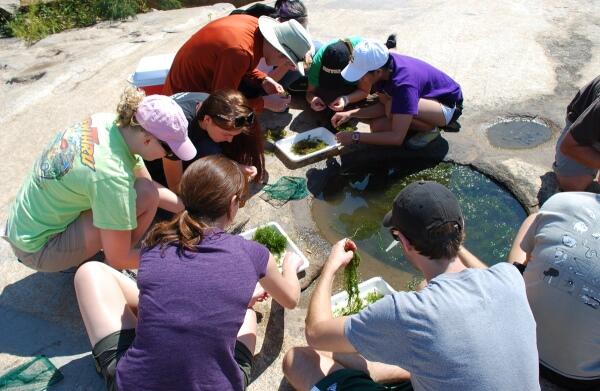
Oct. 28, 2013
‘Science in the Park’
Share this story
Whether it is by hopping on a bike and riding up and down rugged trails, heading onto the water for some rafting or taking a stroll in search of spring warblers, eagles and herons, the parks along the James River offer plenty of ways to enjoy the great outdoors.
It’s also an area brimming with natural wonder. And beneath that wonder is a foundation of science.
That science – geology, plant and animal life, rock pools, and more – is now being showcased through a newly launched component on the James River Park System website called “Science in the Park.”
Visitors to the park use their smartphones as a walking companion to take a guided tour through the fall zone geology, and area students can surf the net from their classrooms to learn more about nature unique to the James River as they click through the site to view videos, lectures and more featuring local experts in those fields.
The initiative, led by Anne Wright, assistant professor of biology in the College of Humanities and Sciences and coordinator of VCU Life Sciences Outreach Education, was created to highlight signature aspects of the park from a scientific perspective. Wright also serves as a board member for The Friends of the James River Park.
The Science in the Park tab offers fun facts, videos and information about the geology, plant and animal life of the James River.
“Visitors to the park can do and view a lot right on their cell phones and it offers them a window into what they can do and see at the park that is science-based,” Wright said. “We hope this effort adds a dimension of understanding and appreciation of the park and the nature there -- there’s more there than meets the eye.”
The site further serves as an educational tool that can be used by the community at large to learn about the value and wonder taking place in their own backyards. There are teaching resources and lesson plans for area school teachers to incorporate into their curriculums and help spark interest in conservation and the environment among youngsters.
For the past year, Wright worked closely with videographer Melissa Lesh, a recent VCU graduate, to create videos that capture the scientific nature of various elements found within the park system. The pair collaborated with Ralph White, park manager emeritus, to narrate a video about fairy shrimp. One about dragonflies and damselflies will be released soon.
The fairy shrimp video, filmed in the wetlands area of the James River Park System by Lesh, Wright and White, was chosen as one of 65 short science-related films highlighted during the Sixth Annual Imagine Science Film Festival in New York earlier this month. The film was selected from a competitive pool of nearly 500 entries.
Fairy shrimp have a short window of time when they may be found. They are found in temporary waters, or vernal pools, that fill up with rain and snow during the winters and then dry up just as fast as summer approaches.
“These are iconic species found in these pools, and we were very excited when we found them one day last year in a system of wetlands in the park,” Wright said.
Another video on the site explores the biology and life in rock pools, or potholes, found in the park. The video features VCU biologist James Vonesh, Ph.D., who teaches a course in community ecology using these geologic marvels that dot the granite bedrock around Belle Isle. Rock pools are typically round or oval in shape and are created when gravel or stones grind in one spot for an extensive period of time. The resulting holes that form are a haven for a variety of plant and animal life and make for an interesting long-term study on ecological processes.
An online plant guide was created to complement the rock pool explorations and highlights a variety of trees, vines, aquatic plants, wildflowers and grasses found in the pools and bedrock around Belle Isle. There is also information about the ongoing research on Atlantic sturgeon being led by VCU Rice Center researchers. Sturgeon have been confirmed returning to the park in the fall, presumably to spawn in the park’s famous rapids.
Moving forward, Wright hopes the project will expand to include more videos and activities on the inhabitants and ecology of the park and the historical past visible along its trails, rocks and waterways. She also hopes to develop watershed /runoff activities and ties to sustainable water quality.
Science in the Park is a partnership between VCU Rice Center, VCU Life Sciences Outreach Education and Friends of the James River Park. The project was supported by a grant from Altria.
Subscribe for free to the weekly VCU News email newsletter at http://newsletter.news.vcu.
Subscribe to VCU News
Subscribe to VCU News at newsletter.vcu.edu and receive a selection of stories, videos, photos, news clips and event listings in your inbox.





